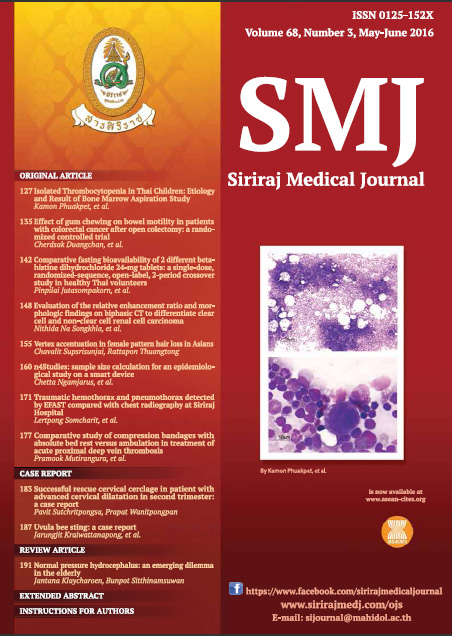Evaluation of the Relative Enhancement Ratio and Morphologic Findings on Biphasic CT to Differentiate Clear Cell and Non-Clear Cell Renal Cell Carcinoma
Keywords:
Biphasic CT, clear cell renal cell carcinoma, non-clear cell renal cell carcinomaAbstract
Objective: To differentiate clear cell and non-clear cell renal cell carcinoma (RCC) using enhancement pattern, relative enhancement ratio and associated findings on CT scan.
Methods: This retrospective study reviewed CT scan in the unenhanced, corticomedullary and nephrographic phase in clear cell and non-clear cell RCC. A total of 49 patients with surgically proven RCC, consisting of 42 clear cell RCCs, and 7 non-clear cell RCCs (6 papillary, 1 chromophobe). Two radiologists compared the degree of enhancement, enhancement pattern, the presence or absence of calcification, perinephric change, pelvicalyceal involvement, neovascularization, venous invasion, lymphadenopathy and distant metastasis.
Results: Both the attenuation value and degree of enhancement in the corticomedullary phase were higher in clear cell RCC than non-clear cell RCC. The relative enhancement ratio in the corticomedullary phase was significantly higher in a clear cell than non-clear cell RCC. The cutoff value of the relative enhancement ratio higher than 1.629 was used to differentiate clear cell RCC from non-clear cell RCC and had the sensitivity, specificity, PPV, NPV and accuracy of 76.2%, 85.7%, 97%, 37.5% and 77.6%, respectively. Heterogeneous enhancement, perinephric change, and neovascularization were found significantly more common in a clear cell than non-clear cell RCC.
Conclusion: The most useful parameter to differentiate clear cell from non-clear cell RCC is relative enhancement ratio in the corticomedullary phase.
Downloads
Published
How to Cite
Issue
Section
License
Authors who publish with this journal agree to the following conditions:
Copyright Transfer
In submitting a manuscript, the authors acknowledge that the work will become the copyrighted property of Siriraj Medical Journal upon publication.
License
Articles are licensed under a Creative Commons Attribution-NonCommercial-NoDerivatives 4.0 International License (CC BY-NC-ND 4.0). This license allows for the sharing of the work for non-commercial purposes with proper attribution to the authors and the journal. However, it does not permit modifications or the creation of derivative works.
Sharing and Access
Authors are encouraged to share their article on their personal or institutional websites and through other non-commercial platforms. Doing so can increase readership and citations.











